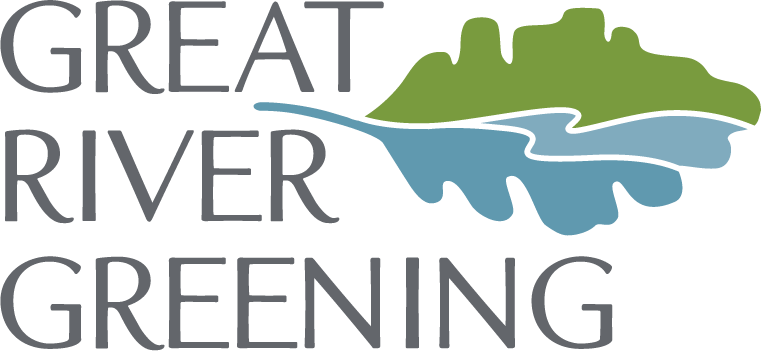Favorite Native Plants for Sun or Shade in Your Own Yard (Including Greening Staff Favorites!)
5/15/2024
Spring is the perfect time to add native plants to your own yard. Adding native plants is a great way to add back biodiversity, improve soil health, use less water, and create beautiful habitats for pollinators, birds, and us! There’s an estimated 50 million acres of cultivated turf in the U.S., which has created a lack of habitat and biodiversity in our communities. But it’s easy to simply add a few native plants such as wildflowers and grasses, native flower shrubs or trees, or even a pollinator garden to have a big impact on the health of Minnesota’s outdoors.
STEP 1: Find a native plant supplier. Ensure the nursery offers plants produced from seeds of local origin. Some of Great River Greening’s preferred vendors include: Landscape Alternatives, MNL, Natural Shore, Out Back Nursery, and Prairie Restorations.
STEP 2: Location, location, location – what’s the sun/shade situation? Some species love a shady understory, while others thrive in direct sun. Native plant nurseries can share details about each species to find the best fit, or take a look at some Great River Greening staff favorites for sun or shade!
STAFF FAVORITES - SUN:
Pasque Flower, Prairie Smoke, Prairie Dropseed, Blazing Star, Purple Coneflower, Gray-headed Coneflower, Bee Balm (aka Monarda Fistulosa or Wild Bergamot), Black-eyed Susan, Yarrow, Swamp Milkweed (aka Rose Milkweed), Anise Hyssop, Blue Vervain, Purple Prairie Clover, Prairie Dropseed (grass), Big Bluestem (grows tall!)
““When the bee balm is in bloom, my pollinator gardens become my happy place in no small part due to this plant. Hard not to enjoy the unbounded enthusiasm the pollinators have for these blooms.” - Wiley, Senior Program Manager”
STAFF FAVORITES - SHADE:
Trillium (spring ephemeral), Wood Anemone, Bloodroot (spring ephemeral), Jacob’s Ladder, Poke Milkweed, Trout Lily, Bluebells, Columbine, Brown-eyed Susan, Pennsylvania sedge, Virginia Waterleaf (watch out, it likes to spread, which may be a benefit or not!), Round-lobed Hepatica, Large-leaved Aster, Golden Alexanders, Ferns (numerous varieties), Wild Ginger (great ground cover), Wild Geranium
““Trout lilies have unique leaves and flowers and are a welcome indicator of spring. These are found along trout streams, so I’m usually in a great mood when I come across them. These are great for wetter areas if growing at home.” - Jake, Ecologist”
STEP 3: In the spring or the fall, get planting! You can start from seed, from seedlings (called plugs), or even larger. If you get plugs in the spring, don’t be surprised if they arrive and aren’t’ bright and green. These are perennials and they have simply overwintered, but their incredible roots will take hold quickly and grow in your yard.
STEP 4: Maintenance. In the first year or two, water your new native plants, especially if there is a drought. Once established, these plants need very little water, and just a bit of weeding. In the fall, leave the plants as is over winter as they offer food for birds and habitat for pollinators. In the spring, don’t rake and clean up until it’s been in the 50s for a week: there are wonderful bugs living in those stems!
STEP 5: Patience! Native plants take time to establish. Good guidance for growing from seed: the first year they sleep, the second year they creep, and the second year they leap. Geat a head start by planting plugs instead of seeds.
P.S. Looking for shrub options? Here are some staff favorites: Dogwoods, Serviceberries, Viburnum, Hazelnut, Dwarf Bush Honeysuckle, Chokecherries
Want to add native plants in your community?
Partner with us. Support Great River Greening. Volunteer.
“Even now, with the natural world in so much trouble —radiant things are bursting forth in the darkest places, in the smallest nooks and deepest cracks of the hidden world. I mean to keep looking every single day until I find them.”
― Margaret Renkl
The Comfort of Crows: A Backyard Year
Photo Credits: Bee balm covered in bees from Kateri’s backyard pollinator garden (Kateri Routh), Yellow and white trout lilies at Eloise Butler Wildflower Garden (Becca Tucker), a before and after of Kateri’s backyard pollinator garden, from the end of winter to middle of summer. (Kateri Routh), Backyard pollinator garden in bloom in Kateri’s St. Paul yard (Kateri Routh)




